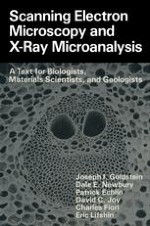1981 | OriginalPaper | Chapter
Materials Specimen Preparation for SEM and X-Ray Microanalysis
Authors : Joseph I. Goldstein, Dale E. Newbury, Patrick Echlin, David C. Joy, Charles Fiori, Eric Lifshin
Published in: Scanning Electron Microscopy and X-Ray Microanalysis
Publisher: Springer US
Included in: Professional Book Archive
Activate our intelligent search to find suitable subject content or patents.
Select sections of text to find matching patents with Artificial Intelligence. powered by
Select sections of text to find additional relevant content using AI-assisted search. powered by
One of the great strengths of scanning electron microscopy is the fact that many specimens can be examined with virtually no specimen preparation. Specimen thickness is not a consideration as is the case in transmission electron microscopy. Therefore, bulk specimens can be examined in the SEM with a size limited only by considerations of accommodation in the specimen stage. For the examination of images of topography contrast from metal and ceramic specimens, the only specimen preparation which is necessary is to ensure that the specimen is thoroughly degreased so as to avoid hydrocarbon contamination and, in the case of insulators, to provide a conductive coating. Techniques for cleaning surfaces include solvent cleaning and degreasing in an ultrasonic cleaner, mechanical brushing, replica stripping, and chemical etching. These techniques should be used starting with the least damaging and employing only the minimum cleaning necessary. Usually the first step is to use a solvent wash such as acetone, toluene, or alcohol in an ultrasonic cleaner. Several specific techniques for cleaning metal surfaces are described by Dahlberg (1976).
